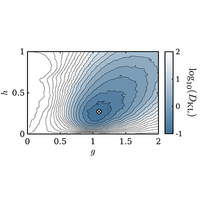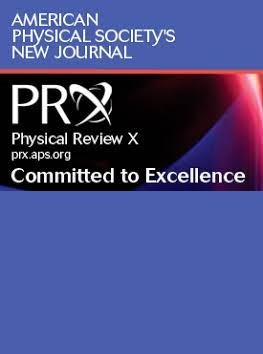通过微观纠缠分布量化量子混沌
IF 11.6
1区 物理与天体物理
Q1 PHYSICS, MULTIDISCIPLINARY
引用次数: 0
摘要
量子混沌 "系统的一个特点是其特征谱和特征状态显示出随机矩阵理论(RMT)所描述的普遍统计特性。然而,局部系统的特征状态也会编码超出 RMT 的结构。为了捕捉这一特征,我们引入了一个框架,使我们能将局部系统中特征状态的集合特性与纯随机状态的集合特性进行比较。特别是,我们的框架定义了量子态集合间距离的概念,利用库尔贝-莱布勒发散(Kullback-Leibler divergence)来比较特征态的纠缠熵(EE)微观规范分布与纯随机态(有适当的约束条件)生成的参考 RMT 分布。这一概念产生了量子混沌的定量指标,它不仅考虑了分布的平均值,还考虑了更高的矩。矩的差异是在由 RMT 分布标准偏差设定的高分辨率尺度上进行比较的,而 RMT 分布标准偏差在系统规模中呈指数级小。因此,该指标可以区分混沌行为和可积分行为,此外还可以量化和比较假定为混沌的两个系统之间的混沌程度(以接近 RMT 行为的程度表示)。我们在局部、最小结构、弗洛克特随机电路以及多体哈密顿典型族--混合场伊辛模型(MFIM)中实现了我们的框架。重要的是,对于哈密顿系统,我们发现必须适当限制参考随机分布,以纳入能量守恒效应,从而描述中谱特征状态的集合特性。该指标可以捕捉到所有模型和参数与 RMT 的偏差,包括那些先前被确定为强混沌的模型和参数,对于这些模型和参数,其他混沌诊断方法(如电平间距统计)看起来具有很强的热效应。在 Floquet 电路中,偏差的主要来源是分布的第二矩,这一点在所有系统规模中都持续存在。对于 MFIM,我们发现 KL 发散在参数空间有显著变化。值得注意的是,我们发现有一小块区域与 RMT 的偏差最小,这表明 "最大混沌 "哈密顿可能存在于参数空间的微调区域。本文章由计算机程序翻译,如有差异,请以英文原文为准。

Quantifying Quantum Chaos through Microcanonical Distributions of Entanglement
A characteristic feature of “quantum chaotic” systems is that their eigenspectra and eigenstates display universal statistical properties described by random matrix theory (RMT). However, eigenstates of local systems also encode structure beyond RMT. To capture this feature, we introduce a framework that allows us to compare the ensemble properties of eigenstates in local systems with those of pure random states. In particular, our framework defines a notion of distance between quantum state ensembles that utilizes the Kullback-Leibler divergence to compare the microcanonical distribution of entanglement entropy (EE) of eigenstates with a reference RMT distribution generated by pure random states (with appropriate constraints). This notion gives rise to a quantitative metric for quantum chaos that not only accounts for averages of the distributions but also higher moments. The differences in moments are compared on a highly resolved scale set by the standard deviation of the RMT distribution, which is exponentially small in system size. As a result, the metric can distinguish between chaotic and integrable behaviors and, in addition, quantify and compare the degree of chaos (in terms of proximity to RMT behavior) between two systems that are assumed to be chaotic. We implement our framework in local, minimally structured, Floquet random circuits, as well as a canonical family of many-body Hamiltonians, the mixed-field Ising model (MFIM). Importantly, for Hamiltonian systems, we find that the reference random distribution must be appropriately constrained to incorporate the effect of energy conservation in order to describe the ensemble properties of midspectrum eigenstates. The metric captures deviations from RMT across all models and parameters, including those that have been previously identified as strongly chaotic, and for which other diagnostics of chaos such as level spacing statistics look strongly thermal. In Floquet circuits, the dominant source of deviations is the second moment of the distribution, and this persists for all system sizes. For the MFIM, we find significant variation of the KL divergence in parameter space. Notably, we find a small region where deviations from RMT are minimized, suggesting that “maximally chaotic” Hamiltonians may exist in fine-tuned pockets of parameter space.
求助全文
通过发布文献求助,成功后即可免费获取论文全文。
去求助
来源期刊

Physical Review X
PHYSICS, MULTIDISCIPLINARY-
CiteScore
24.60
自引率
1.60%
发文量
197
审稿时长
3 months
期刊介绍:
Physical Review X (PRX) stands as an exclusively online, fully open-access journal, emphasizing innovation, quality, and enduring impact in the scientific content it disseminates. Devoted to showcasing a curated selection of papers from pure, applied, and interdisciplinary physics, PRX aims to feature work with the potential to shape current and future research while leaving a lasting and profound impact in their respective fields. Encompassing the entire spectrum of physics subject areas, PRX places a special focus on groundbreaking interdisciplinary research with broad-reaching influence.
 求助内容:
求助内容: 应助结果提醒方式:
应助结果提醒方式:


